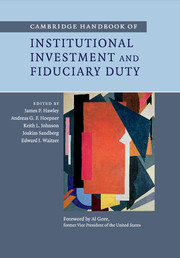Book contents
- Frontmatter
- Contents
- List of figures
- List of tables
- List of contributors
- Foreword
- 1 Introduction
- Part I Fiduciary duty: a global outlook
- Part II Fiduciary duty and the landscape of institutional investment
- 8 The philanthropic fiduciary: challenges for nonprofits, foundations and endowments
- 9 Paradigm lost: employment-based defined benefit plans and the current understanding of fiduciary duty
- 10 Economically targeted investing: changing of the guard
- 11 Institutional investment in the European Union Emissions Trading Scheme
- 12 Have institutional fiduciaries improved securities class actions? A review of the empirical literature on the PSLRA’s lead plaintiff provision
- 13 The future of fiduciary obligation for institutional investors
- Part III Challenging conventional wisdom on fiduciary duty
- Part IV Towards a broader interpretation of fiduciary duty
- Part V Beneficiaries’ roles and viewpoints
- Part VI Fiduciary duty and governance
- Index
- References
9 - Paradigm lost: employment-based defined benefit plans and the current understanding of fiduciary duty
Published online by Cambridge University Press: 05 April 2014
- Frontmatter
- Contents
- List of figures
- List of tables
- List of contributors
- Foreword
- 1 Introduction
- Part I Fiduciary duty: a global outlook
- Part II Fiduciary duty and the landscape of institutional investment
- 8 The philanthropic fiduciary: challenges for nonprofits, foundations and endowments
- 9 Paradigm lost: employment-based defined benefit plans and the current understanding of fiduciary duty
- 10 Economically targeted investing: changing of the guard
- 11 Institutional investment in the European Union Emissions Trading Scheme
- 12 Have institutional fiduciaries improved securities class actions? A review of the empirical literature on the PSLRA’s lead plaintiff provision
- 13 The future of fiduciary obligation for institutional investors
- Part III Challenging conventional wisdom on fiduciary duty
- Part IV Towards a broader interpretation of fiduciary duty
- Part V Beneficiaries’ roles and viewpoints
- Part VI Fiduciary duty and governance
- Index
- References
Summary
Introduction
This volume is witness to the importance of the meaning and import of “fiduciary duty” for the responsibilities of those who make investment-related decisions on behalf of others – “decision-makers” – especially institutional investors, including pension funds. Focus on the subject is animated by the impact of such decisions on those ostensibly to be benefited by them. However, it has also been spurred by concern about how decision-makers’ choices bear upon the behaviors of the enterprises in which they invest and diverse stakeholders in the enterprise and the larger society. Here we largely attend to beneficiaries although we will in some measure address distinct but related concerns of others.
We consider decision-makers for funded employment-based defined benefit plans (“plans”) in the United States and the interests they might legitimately seek to advance. Plans promise workers – and sometimes their spousal survivors – a lifetime income starting at retirement – a “pension.” We refer to as “members” those who potentially qualify for a pension by virtue of their or their spouse’s employment at the enterprise with which the plan is associated. To assure that the promises are kept, workers’ and/or employers’ contributions to the plan are pooled and invested. Plans, like other retirement schemes, are usually subsidized by tax credits and/or deductions for contributions made and no or lower taxation of investment returns and/or plan payouts after retirement.
- Type
- Chapter
- Information
- Publisher: Cambridge University PressPrint publication year: 2014

